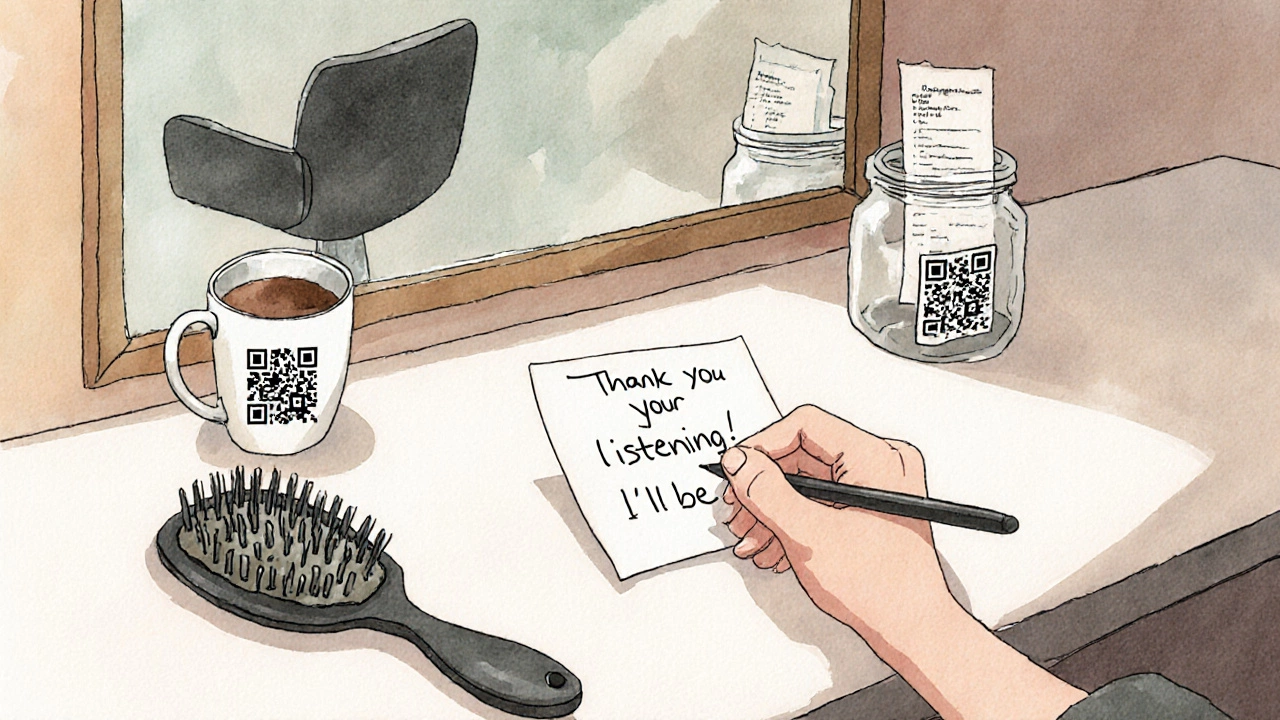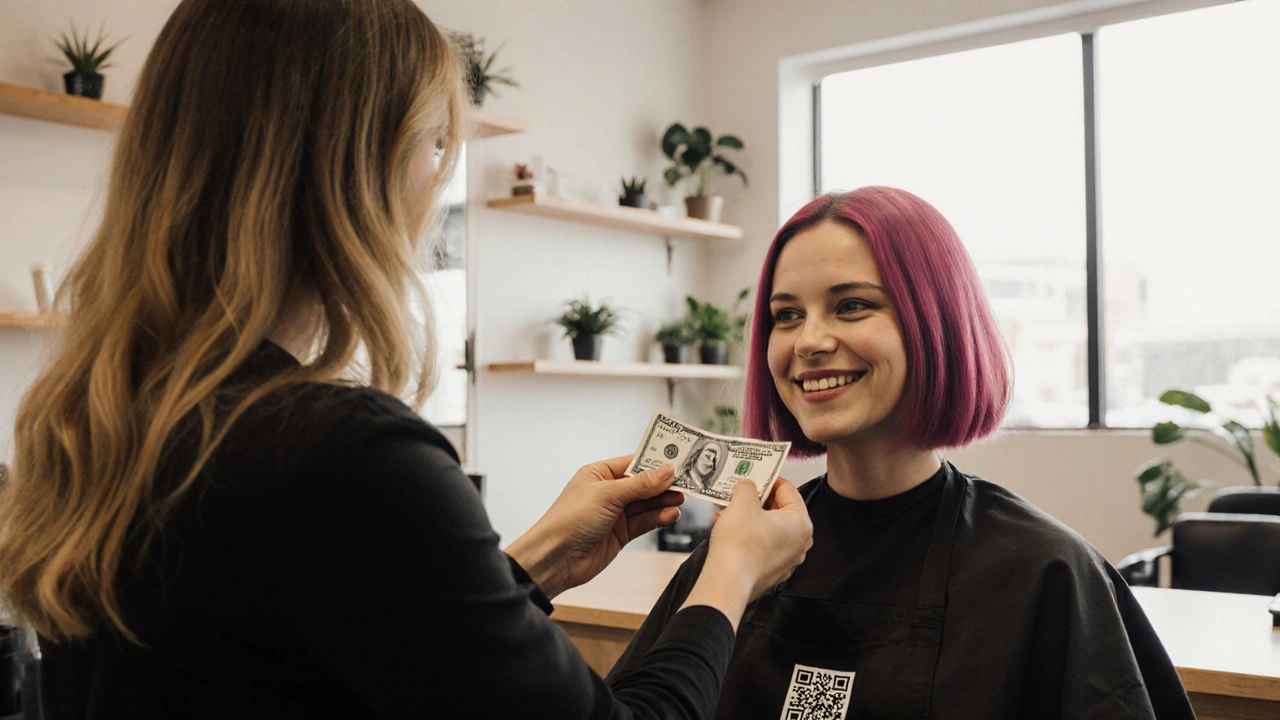Hairdresser Tip Calculator
Calculate Your Tip
Find out how much to tip based on your location and service quality.
Your tip recommendation will appear here
It’s been years since you last handed over cash to your hairdresser after a trim. Maybe you paid with a card. Maybe the salon added a service fee. Now you’re wondering: do people still tip hairdressers? The answer isn’t as simple as yes or no - it depends on where you are, what you paid, and what kind of experience you got.
Tipping Culture Has Changed - But It’s Not Dead
In the early 2000s, tipping your hairdresser was as automatic as saying ‘thank you.’ You gave 15% to 20% because that’s what everyone did. But things shifted. Salons started adding service charges. Credit card machines made cash less common. Some places even include a ‘gratuity’ in the final bill. So now, when you walk out with a fresh cut and your card receipt in hand, you pause. Do you leave extra? Should you?
The truth? Tipping is still expected in many places - but not always as cash. In New Zealand, where I live in Wellington, tipping isn’t built into the culture like it is in the U.S. Most salons don’t expect it. But if your hairdresser went above and beyond - stayed late, fixed a color disaster, remembered your kid’s name - you’ll still see people leaving $10 to $20 on the counter. It’s not a rule. It’s a thank-you.
Where Tipping Still Matters Most
Not all countries treat tipping the same. In the United States, it’s still standard to tip 15%-25% depending on service quality. Hairdressers there often rely on tips to make up for low base pay. But in Australia, Canada, and the UK, tipping is optional and usually only done for exceptional service. In New Zealand, it’s even more relaxed. You’re not obligated. But if you’re happy with your result, leaving a little extra is seen as thoughtful - not weird.
Here’s what most people do in different places:
- United States: 15%-25% is standard. Many clients tip even if there’s a service charge.
- Canada & UK: 10%-15% for great service. Not expected, but appreciated.
- Australia & New Zealand: Rarely expected. $5-$20 is a common gesture for outstanding work.
- Europe (Germany, France, etc.): Rounding up the bill is the norm. No formal tipping.
So if you’re traveling or booking a salon abroad, check local norms. Don’t overtip where it’s not needed. Don’t under-tip where it’s expected.
What If the Salon Already Charges a Service Fee?
Some salons now add a 10%-15% service charge to every bill. They’ll say it’s ‘to support staff.’ That sounds good - until you realize the money might not go to your stylist. In many cases, the fee goes to the salon owner, not the person who cut your hair. That’s why you still need to decide: did your stylist earn extra?
Ask yourself: Did they spend 15 minutes extra to fix your roots? Did they give you honest advice on products? Did they make you feel heard? If yes, leave a tip - even if there’s a service charge. The fee covers overhead. The tip rewards skill and care.
Some salons in Wellington have started labeling service charges clearly: ‘This fee supports facility costs, not staff.’ That’s honest. And when you see that, tipping becomes even more meaningful.

How Much Should You Tip in 2025?
There’s no universal formula. But here’s a simple way to think about it:
- Basic service (cut, blow-dry): $5-$10 if you’re happy.
- Color or highlights: $15-$30, depending on complexity and time.
- Full salon day (cut, color, treatment): 10%-15% of the total, or $20-$50.
- Exceptional service: Go higher. $50+ if they saved your wedding hair or gave you a 30-minute consultation on hair health.
Some people tip based on what they’d pay for coffee or lunch. If you spent $120 on a color and you’d normally spend $15 on dinner out, $15-$20 extra feels right. It’s not about percentages. It’s about value.
And here’s something most people forget: if you’re a regular, your tip doesn’t have to be the same every time. One visit you leave $10 because your cut was perfect. The next, you leave nothing because the stylist was rushed and didn’t listen. That’s fair. Tipping should reflect the experience - not a habit.
How to Tip Without Cash
Cash is dying. Most salons now take card payments. But you can still tip digitally.
In New Zealand, many salons use apps like PayNow, Zip, or Afterpay for payments. Some let you add a tip right on the receipt screen. Others have a QR code on the counter labeled ‘Tip your stylist.’ If you see one, scan it. It’s quick, secure, and goes straight to your stylist’s account.
If there’s no digital option, you can send a small bank transfer. Text your stylist: ‘Hey, loved the color - here’s a little something.’ Then send $20 via bank app. They’ll notice. And they’ll remember you.

What If You Can’t Afford to Tip?
Here’s the honest truth: no one should feel pressured to tip if they can’t afford it. Your stylist shouldn’t make you feel guilty. A good stylist knows you’re paying for a service - not charity. If you’re on a tight budget, skip the tip. But say thank you. Write a Google review. Refer a friend. Leave a five-star rating. Those things matter just as much.
Many stylists say: ‘I’d rather have one loyal client who tells five people about me than five clients who tip $5 and never come back.’ Your loyalty is valuable. Your word is currency.
Why Some Stylists Don’t Want Tips Anymore
Not everyone agrees on tipping. Some stylists in Wellington now charge a flat rate that includes everything. They say: ‘If I’m paid fairly, I don’t need tips.’ They set their prices to cover living wages, benefits, and training. That’s becoming more common in independent salons that value transparency.
These salons often post their pricing clearly: ‘$120 for full color and cut - no hidden fees, no pressure to tip.’ That builds trust. And for clients who hate the awkwardness of tipping, it’s a relief.
But here’s the catch: even in these salons, clients still leave tips. Why? Because they want to say thanks. Because they know their stylist worked harder than the price tag suggests. It’s not about money. It’s about appreciation.
Final Thought: Tipping Is About Respect, Not Rules
There’s no law that says you must tip your hairdresser. But there’s a quiet social contract: if someone gives you care, attention, and skill - you show gratitude. That doesn’t always mean cash. It can mean a handwritten note. A referral. A review. A return visit.
So yes - people still tip hairdressers. But it’s not about obligation anymore. It’s about choice. And the best tips? They come from people who didn’t feel forced. They came because they were genuinely happy.
If you’re unsure, ask yourself: Would I tip a barista who made my coffee perfectly? A mechanic who fixed my car on time? A therapist who listened without judgment? If the answer is yes, then your hairdresser deserves the same.
Is it rude not to tip a hairdresser in New Zealand?
No, it’s not rude. Tipping isn’t expected in New Zealand like it is in the U.S. Most salons don’t include tips in their pricing, and stylists are paid a fair wage. Not tipping won’t offend anyone - but leaving a small amount for great service is seen as a kind gesture.
Should I tip if the salon adds a service charge?
It depends. If the service charge goes to the salon owner, not your stylist, then yes - consider tipping separately. If the salon clearly states the charge goes to staff, tipping is optional. Always ask if you’re unsure. A good salon will be transparent.
How much should I tip for a $150 hair color and cut?
In New Zealand, $15-$30 is common for a high-quality service like that. In the U.S., 20% ($30) is standard. But it’s not about the percentage - it’s about how much you value the result. If your color looked exactly how you wanted and your stylist spent extra time, $40 is fair.
Can I tip with a card or digital payment?
Yes. Many salons now have QR codes or digital tipping options on receipts. You can also send a direct bank transfer or use apps like PayNow or Zip. Just make sure the tip goes directly to your stylist - not the business account.
What if I’m unhappy with my haircut?
Don’t tip. But don’t walk out angry either. Politely ask for a fix. Most stylists will correct it at no extra cost. If they refuse or seem dismissive, leave a review. Your feedback helps them improve - and helps others avoid the same mistake.


